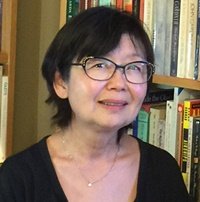KIOKU
By Shirley Asano
The old woman paints a cone-shaped green mountain onto heavy white paper, and in front of the mountain, a small kimono-clad figure, one triangle for a body and an inverted one for a face, onto which she draws eyes, nose, mouth, creating a ningyo, a doll, to delight any child. Her brush wavers as she streaks thinned cerulean blue across the remaining white expanse.
The young teacher approaches her: “a lovely picture,” she says.
“My hand used to be so steady,” the old woman laments, thinking of the fine calligraphic strokes that once had been hers.
“Look,” the teacher says, “the white you’ve left visible is like a bank of clouds sailing across the blue sky.”
“I don’t remember how the sky behind the mountain really appeared,” the old woman says.
“Maybe your hand has remembered for you,” the teacher says.
The old woman’s husband wouldn’t have anything to do with the Senior Center. He passed a year ago, and now the old woman finds the center not an unpleasant place to spend a morning once a week. Today, it is sunny, and the seniors sit outside at two picnic tables in the faint spring breeze under the flickering shade of a sycamore. Still, the old woman wears a knit vest under her heavy sweater. She is no longer the atsugari, warm-blooded one, she was in her youth.
“Today,” the young teacher says firmly as though to stop time, as if today didn’t flow inexorably from yesterday into tomorrow, “we’ll work on portraits. Pair up and draw each other. For my demo, I’d like a volunteer.”
The Turkish lady volunteers. Doubtless a beauty in her youth. You can see it in her fine high cheekbones. The old woman identifies everyone by nationality because names elude her. There is the Italian lady, the Hispanic lady, and the Irish gentleman. And there is a cluster she thinks of as the American ladies, because they claim no other origin than where they are, here, in Los Angeles. The old woman is called “Mimi” by the Americans and others who cannot manage the syllables in Miyeko, her Japanese first name. That is fine with her. For her part, she is adept at sidestepping the use of names.
The Turkish lady reminds the old woman of the bijin, the great beauty, of Tamana where the old woman grew up. LIke the bijin, the Turkish lady is tall. Her carriage is upright, so rare among the center’s seniors, men as well as women. It makes her seem invulnerable to adversity. That was how the village viewed the bijin of Tamana too. But when the bijin lost her husband in the war against the United States, she caved in to grief, and her family, embarrassed by her public displays of emotion, married her off to her departed husband’s younger brother.
The old woman, reminiscing, has missed the teacher’s demonstration. No matter. She and the other students generally do what they want with the paints, brushes, pencils, paper that the Center provides. Some do practically nothing at all but chat, and that’s fine too. The sun filtering through the sycamore splatters the old woman’s sheet of paper with shadows of leaves. It would be nice to trace and color them.
“Would you like me to be your partner,” the young teacher asks the old woman. “I’m afraid the others have already paired up and we’re an odd number today.”
The old woman, confused, squints up at the teacher. “You can draw me,” the teacher explains.
“I cannot draw people,” the old woman says. Staring into another’s face, attempting to see into their thoughts, strikes her as offensive.
“If you change your mind, I’m here for you.”
The old woman thanks the teacher, knowing it must be frustrating for her to work with seniors who can be as uncooperative as children.
The old woman traces leaf patterns in green pencil while the others attempt drawing each other. She then paints in watercolor translucent triangles of pink on top of the leaf design in the form of a kimono-clad doll. The leaf design works as a kimono pattern. The Turkish lady breaks from her drawing to exclaim over the old woman’s artwork: “How beautiful it is!” Others join in praising the result. One of the American ladies says, “Mimi, show me how it’s done.” The old woman, embarrassed, says, “Nothing, it is nothing.” What pleases her is not her doll but the goodwill of her fellow seniors. This is what she will recall of her morning and recount to her daughter-in-law, who will drive her home from the center.
That evening the old woman dreams of her husband, and wakes with a start. She has not thought of him in several days. She rises from bed and walks over to her husband’s photo, which hangs on the wall opposite.
“Warukatta ne, that was wrong of me,” she says. “I’m sorry.”
Even so, she cannot resist the next day putting on a dab of perfume that he had not cared for but that she likes. She does this before their grandson, now a young man, picks her up at her apartment to take her out to lunch. She enjoys his cheerful company, and his good looks bring back to her his grandfather.
Four months later the seniors at the center are making dolls to decorate a nearby center for children at risk. “Play, enjoy!” the young teacher tells them.
“I want to make a doll for a boy,” says one of the men.
“Do it!” the teacher says with a smile.
This project stymies the old woman. She admires the Hispanic lady who is making dolls out of multi-colored yarn.
“Your son said you’d been ill. How are you feeling today?” the teacher asks the old woman.
“Fine, thank you,” the old woman says. She had suffered a mild heart attack and was briefly hospitalized, but does not want to go into that. She is glad to be back in class.
“Do you need help getting started?” the teacher asks.
“Thank you,” the old woman says.
“Here are some supplies.” The teacher sets paper, yarn and scissors in front of the old woman. “Do something fun, easy. See, like those ladies.”
The old woman glances over at the American ladies. They are making strings of paper dolls out of colorful wrapping paper.
The old woman’s hands, not used to being idle, reach for several sheets of paper, which she cuts into squares, and folds and unfolds, folds and unfolds, and fits together. She creates a flat, kimono-clad doll, about five inches long. When was the last time she had seen something like this?
A boy’s thin, smiling face comes into focus. But his name is not in her kioku, her memory. Nonetheless, she can see he wears a khaki school uniform and rides his bicycle back and forth, back and forth, across the street in front of her home as she, a youngster herself, studies history on the veranda. Watching him from a distance is like watching a movie, only in color before there was color in movies.
“I don’t know why he rides back and forth like that,” she said to a friend at school.
“Don’t you?” her friend said. “He likes you.”
“Masaka, that can’t be. He doesn’t know me.”
“But it is true. I heard it from his sister.”
During the war, along with so many in the neighborhood, the boy who rode the bicycle was inducted. The old woman recalls how the boy’s sister implored her to write to him. High school boys and girls went to separate schools in those days. The old woman’s parents disapproved of the request, but she secretly wrote the bicycle boy a note wishing him well and made for him, yes, a paper doll, like the one she folded today. It was the custom, done for good luck.
The old woman struggles to recall the name for those flat paper dolls.
The boy wrote back to her. She read his letter in an air raid shelter near the Kumamoto factory where she had been sent to sew military uniforms. He was training to become a pilot. When he flew his plane into battle her doll, he said, would be with him. Eventually, news came that he would not be returning from the war.
“Shinjirarenai, I can’t comprehend it,” the old woman now mutters to herself, repeating what she said many years ago on learning of the bicycle boy’s death. She suddenly unfolds the doll she created, smoothing the pieces of paper as flat as possible. She runs her hand over and over them, but cannot rid them of the creases she so precisely made.
A year after Japan’s surrender the old woman, then nineteen, sailed to California. It was a rough passage. She had left her hometown to avoid the marriage her parents were arranging for her with an older man. “Iya, I don’t want to,” she had told them in a burst of flagrant disobedience. In Los Angeles, she stayed with a cousin already living there. She later married a Japanese-American man who had been interned in the Heart Mountain camp during the war. She bore him a son, and her son had a son. Looking after three generations she grew old as each day folded inexorably from yesterday into today and tomorrow.
“What happened to the lovely doll you were working on?” the teacher says.
The old woman starts, looks up. “It was no good,” she says.
“There’s lots more paper. Why not try something new then?” the teacher says, smiling.
The old woman reaches for a fresh sheet of paper and runs her hand over the smooth surface, memories stirring, her heart beating hard.
About the Author:

Shirley Asano is a Southern California writer who is currently working on a collection of linked short stories. Focusing on the immigrant experience she explores in her fiction the intersections of cultures and the transformation of interior lives that consequently occurs. Her fiction has appeared in various literary journals, and her nonfiction in the Los Angeles Times and the News-Press. Shirley holds a B.A. in English from the University of California, Los Angeles; M.A. in theology from Fuller Theological Seminary; and, J.D. from the University of Southern California.



















